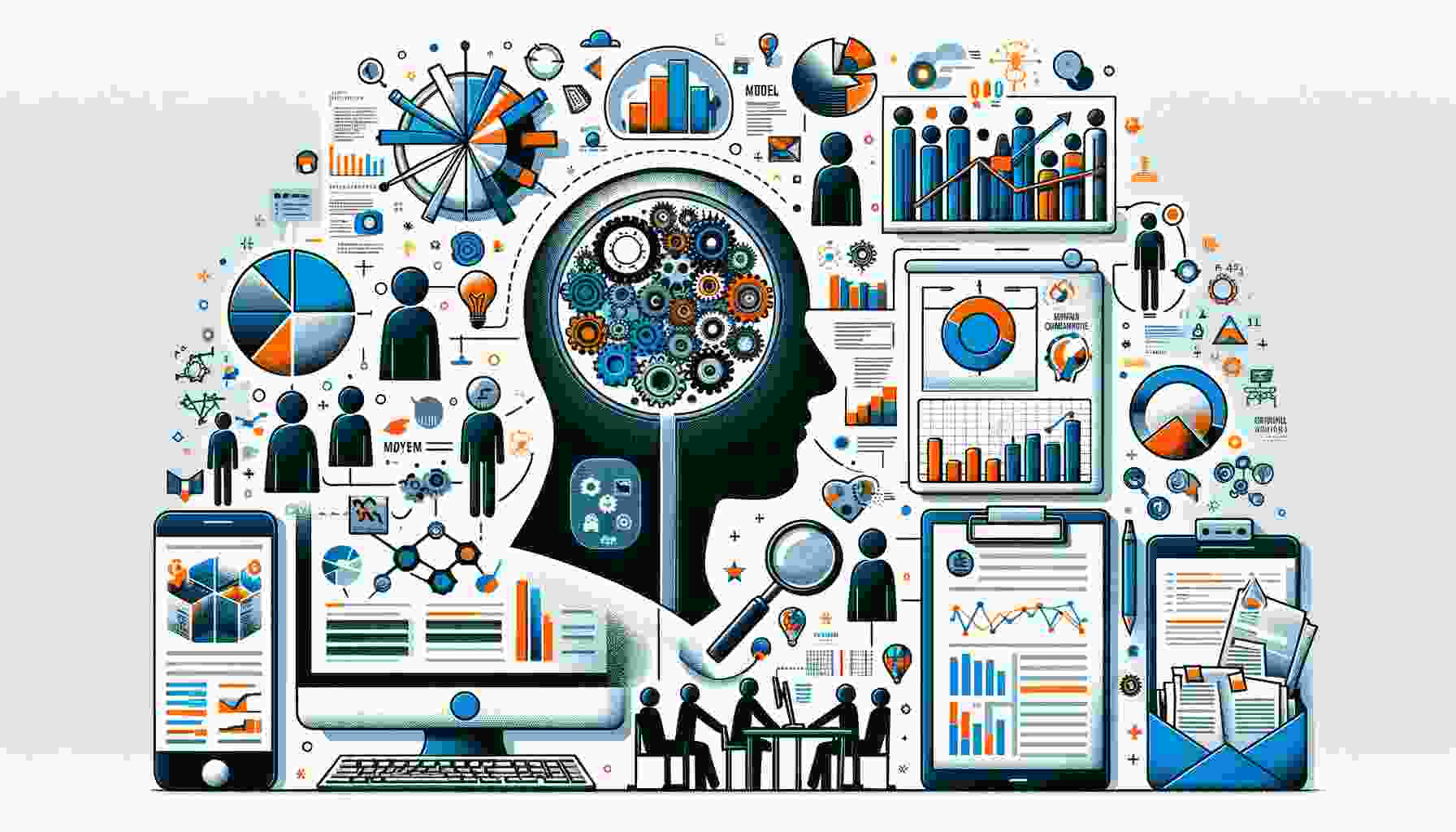A Decision Support System (DSS) is an interactive information system that helps decision-makers use data and models to solve unstructured or semi-structured problems. These systems assist in making informed and sound decisions by analyzing large amounts of data, providing comprehensive reports, and forecasting future trends.
In this article, we will explain “What is a Decision Support System (DSS)?, its role in AI, key components, and everything you want to know about it in detail. So why wait? Keep reading this article, written by AI Scientists at All About AI.
What Is a Decision Support System?: Not Your Average Superhero’s Sidekick!
Imagine you have a big, smart helper called a Decision Support System (DSS). It’s like a magic computer that helps people make tough decisions by using lots of information and special tools. Think of it as having a super smart friend who can help you solve tricky puzzles by giving you hints and ideas.
What is a Decision Support System (DSS)? – An Overview
Now that you understand the basic concept of “What is a Decision Support System (DSS)?, let’s get started by taking a quick look at it.

Data Integration:
DSS systems integrate data from multiple sources, including internal databases, external data feeds, and manual inputs. This integration allows for a more holistic view of the problem at hand, ensuring that decisions are made based on comprehensive and up-to-date information.
Analytical Tools:
DSS utilizes a range of analytical tools and techniques, such as statistical analysis, optimization models, and forecasting methods. These tools help in identifying patterns, trends, and relationships in the data, which can be crucial for making informed decisions.
User-Driven:
These systems are designed with the end-user in mind, ensuring that they are accessible to decision-makers who may not have extensive technical expertise. This user-centric approach includes intuitive interfaces and the ability to customize reports and analyses.
Interactive:
DSS are interactive, allowing users to manipulate and explore data, test out different scenarios, and see the impact of various decision options. This interactive nature helps in understanding complex problems and evaluating different strategies.
Adaptable:
They are adaptable to different business needs and contexts. Whether it’s for financial analysis, marketing strategy, or operational efficiency, a DSS can be customized to address specific challenges and objectives.
DSS is distinct from standard operational applications in several key aspects:
Focus:
Unlike operational applications that are designed for routine tasks and processes, DSS is specifically geared towards supporting complex decision-making processes.
Flexibility:
DSS is more flexible and adaptable compared to operational applications. They can handle a wider range of data inputs and are designed to provide customized outputs.
User Engagement:
DSS requires active engagement from users, who interact with the system to explore data and generate insights. In contrast, operational systems often run automatically or with minimal user interaction.
Data Analysis:
Operational applications are generally focused on data entry, storage, and retrieval. DSS, on the other hand, places a stronger emphasis on data analysis and interpretation, helping to draw meaningful insights from the data.
The Role of AI in Decision Support Systems
After knowing “What is a Decision Support System (DSS)?” let’s understand its role in the world of AI. The integration of Artificial Intelligence (AI) into Decision Support Systems has led to the creation of Intelligent Decision Support Systems (IDSS).
These systems enhance traditional DSS capabilities with AI-driven insights, predictive analytics, and more sophisticated data processing techniques.
Predictive Analytics:
AI in DSS enables predictive analytics, where the system can forecast future trends and outcomes based on historical data. This capability is particularly useful in areas like market analysis, risk assessment, and demand forecasting.
Machine Learning:
Machine learning algorithms within IDSS can identify patterns and anomalies in large data sets that human analysts might miss. This aspect is crucial for uncovering hidden insights and making data-driven decisions.
Natural Language Processing:
AI-powered DSS often includes natural language processing (NLP), allowing users to interact with the system using natural language queries. This makes the system more accessible and intuitive to use.
Adaptive Learning:
AI enables the system to learn from past decisions and outcomes, continuously improving its recommendations and insights. This learning capability ensures that the system becomes more effective and accurate over time.
Automation:
AI in DSS can automate certain decision-making processes, especially those that are repetitive or require processing large volumes of data. This automation not only speeds up the decision-making process but also reduces the potential for human error.
Key Components of a Decision Support System
A Decision Support System is typically comprised of three key components: the knowledge base, the software system, and the user interface.

Knowledge Base
The knowledge base is a critical component of a DSS, providing the necessary data and information for decision-making.
Data Repository:
This includes a vast collection of historical data, documents, and other relevant information that the system uses to make decisions.
Model Base:
The model base stores various mathematical and analytical models that the system uses to process data and simulate different scenarios. These models can range from simple statistical tools to complex predictive algorithms.
Rule Base:
This consists of a set of rules and algorithms that guide the system in data processing and decision-making. These rules are often based on industry best practices or specific organizational policies.
Update Mechanism:
A crucial aspect of the knowledge base is its ability to update and incorporate new data and information, ensuring that the system’s decisions are based on the most current data.
Integration:
The knowledge base integrates data from both internal and external sources, providing a comprehensive view of the information relevant to the decision-making process.
Software System
The software system is the core of a DSS, performing the necessary computations and processing to generate insights and recommendations.
Processing Engine:
This is the heart of the software system, where data is processed using the models and algorithms stored in the model base. It’s responsible for analyzing the data, running simulations, and generating outputs.
Analytical Tools:
The software system includes a range of analytical tools for data analysis, ranging from simple statistical tools to complex data mining techniques. These tools help in extracting meaningful insights from large and complex datasets.
Customization:
The software system can be customized to suit the specific needs of the organization and the decision-making context. This includes the ability to adjust models, change parameters, and configure outputs.
Scalability:
A key feature of the software system is its scalability, allowing it to handle increasing amounts of data and more complex models as the organization’s needs grow.
Security:
Given the sensitive nature of the data and the importance of the decisions being made, the software system includes robust security features to protect data integrity and confidentiality.
User Interface
The user interface is the point of interaction between the decision-maker and the DSS, designed to be intuitive and user-friendly.
Accessibility:
The interface is designed to be accessible to users with varying levels of technical expertise, ensuring that decision-makers can effectively use the system regardless of their background.
Visualization Tools:
It includes various data visualization tools, such as charts, graphs, and dashboards, which help users understand complex data and insights visually.
Interaction:
The interface allows users to interact with the system, inputting data, querying information, and exploring different scenarios. This interactive capability is crucial for effective decision-making.
Customization:
Users can customize the interface according to their preferences and needs, including the layout, the types of reports generated, and the level of detail presented.
Feedback Mechanism:
The interface often includes a mechanism for users to provide feedback on the system’s performance and outputs, which can be used to improve the system over time.
Types of Decision Support Systems
There are several types of Decision Support Systems, each designed to address different types of decision-making needs.

Data-driven DSS:
Focuses primarily on the processing and analysis of large sets of data. These systems are commonly used in situations where the decision-making process is heavily reliant on data, such as market analysis or operational efficiency studies.
Model-driven DSS:
Relies on mathematical models and simulations to support decision-making. These are often used in scenarios where it’s possible to simulate different options and outcomes, such as financial forecasting or logistics planning.
Communication-driven and Group DSS:
Designed to support decision-making in a group context. These systems facilitate communication and collaboration among team members, helping groups to reach consensus and make collective decisions.
Knowledge-driven DSS:
Provides specialized problem-solving expertise and knowledge. These systems are often used in areas where specific expertise is required, such as medical diagnosis or legal compliance.
Document-driven DSS:
Manages and retrieves large volumes of unstructured data, such as documents and reports. These systems are useful in scenarios where decisions are based on the analysis of text-based information, like legal case analysis or research and development.
Practical Applications of DSS in Various Industries
Now that you completely understand “What is a Decision Support System (DSS)?” let’s learn about its implementation across a wide range of industries, each leveraging its capabilities to address industry-specific challenges.
Healthcare:
In healthcare, DSS is used for diagnosing diseases, planning treatment protocols, and managing hospital resources. For instance, a DSS might analyze patient data to recommend the most effective treatment plan or manage schedules and resources in a hospital.
Agriculture:
In agriculture, DSS helps in crop planning, weather forecasting, and resource management. Farmers can use DSS to decide on the best time to plant or harvest, or how to allocate resources like water and fertilizers most effectively.
Corporate Operations:
In the corporate world, DSS is utilized for financial analysis, strategic planning, and project management. Companies might use a DSS to forecast market trends, analyze financial risks, or manage large, complex projects.
Future of Decision Support Systems
The future of Decision Support Systems is likely to be shaped by several key trends and developments.

Integration with Emerging Technologies:
Future DSS are expected to integrate more closely with emerging technologies like the Internet of Things (IoT), blockchain, and advanced analytics. This integration will enable more real-time data analysis and decision-making.
More Advanced AI Capabilities:
The AI components of DSS are likely to become more sophisticated, with improved capabilities in areas like machine learning, predictive analytics, and natural language processing. This will make DSS even more powerful in terms of their ability to analyze data and generate insights.
Increased Customization and Flexibility:
As businesses and organizations become more diverse and their decision-making needs more specific, DSS will need to offer increased customization and flexibility to meet these varied needs.
Enhanced User Experience:
Future DSS are expected to feature more intuitive and user-friendly interfaces, making them accessible to a wider range of users and decision-making contexts.
Greater Emphasis on Data Privacy and Security:
As DSS become more central to critical decision-making processes, there will be an increased focus on ensuring data privacy and security. This is particularly important given the sensitive nature of the data often involved in these decisions.
Want to Read More? Explore These AI Glossaries!
Dive into the realm of artificial intelligence with our meticulously selected glossaries. Perfect for beginners and advanced learners alike, there’s always a new discovery awaiting!
- What is Anytime Algorithm?: An Anytime Algorithm, in the context of AI, is a computational method that aims to generate progressively better solutions to a problem, even with limited time or resources.
- What is Application Programming Interface?: Application Programming Interface (API) is a crucial component in the realm of software development and AI systems.
- What is Approximate String Matching?: Approximate String Matching (ASM), also known as fuzzy string matching or approximate string searching, is a fundamental concept in the field of Artificial Intelligence (AI) and natural language processing.
- What is Approximation Error?: Approximation error, in the context of AI and mathematics, refers to the discrepancy between the actual value of a parameter or output and the estimated value obtained through an approximation method or algorithm.
- What is an Argumentation Framework?: An argumentation framework is a structured representation of arguments and their relationships, used to model and analyze reasoning processes in AI systems.
FAQs
Here are some of the most commonly asked questions about the topic other than “What is a Decision Support System (DSS)?”
What is an example of a Decision Support System?
Why is Decision Support System important in decision-making?
How can a Decision Support System (DSS) help make decisions?
What are the disadvantages of a decision support system?
Conclusion:
Decision Support Systems are powerful tools that have transformed the way organizations make decisions. By leveraging data, advanced analytics, and AI, DSS enhances decision-making processes across various industries. As technology continues to evolve, so too will the capabilities and applications of DSS, further solidifying their role as essential tools in modern decision-making.
Now that you understand “What is Decision Support System (DSS)?” doesn’t mean you know everything about AI. To understand more AI-related concepts, theories, and terms, check out more articles in our AI Terminology Book.





